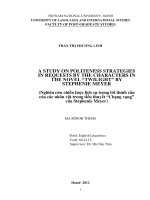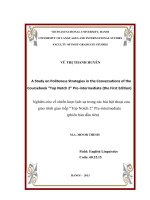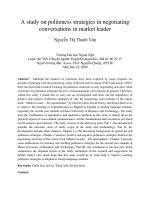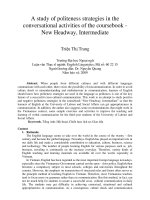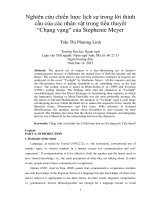A study of politeness strategies in the conversational activities of the coursebook - New Headway, Intermediate
Bạn đang xem bản rút gọn của tài liệu. Xem và tải ngay bản đầy đủ của tài liệu tại đây (129.66 KB, 4 trang )
A study of politeness strategies in the
conversational activities of the coursebook -
New Headway, Intermediate
Triệu Thị Trang
Trường Đại học Ngoại ngữ
Luận văn Thạc sĩ ngành: English Linguistics; Mã số: 60 22 15
Người hướng dẫn: Dr. Nguyễn Quang
Năm bảo vệ: 2009
Abstract. When people from different cultures and with different languages
communicate with each other, there exists the possibility of miscommunication. In order to avoid
culture shock or misunderstanding and misbehaviour in communication, learners of English
should know how politeness strategies are used in the language as politeness is one of the key
factors of a successful cross-cultural communication. This work is an attempt to study positive
and negative politeness strategies in the coursebook “New Headway, Intermediate” so that the
learners of English at the University of Labour and Social Affairs can get appropriateness in
communication. In addition, the author also suggests some recommendations that might work in
the Vietnamese context, some sample exercises and activities to improve the teaching and
learning of verbal communication for the third-year students of the University of Labour and
Social Affairs.
Keywords. Tiếng Anh; Hội thoại; Chiến lược lịch sự; Giao tiếp
Content
1. Rationale.
The English language seems to take over the world in the course of the twenty – first
century and become the global language. Nowadays, English has played an important role in
our daily life and made a considerable contribution to education, culture, business, science
and technology. The number of people learning English for various purposes such as job,
business, traveling is continually on the increase everyday. Therefore, variety kinds of
English teaching and learning materials are available all over the world, especially in
Vietnam.
In Vietnam, English has been regarded as the most important foreign language nowadays,
especially since the Vietnamese Government carried out the open – door policy. English then
becomes a compulsory subject in most schools, colleges and universities throughout the
country. However, the emphasis on transmission of structural rules and forms often serves as
the principle method of teaching English in Vietnam. Therefore, most Vietnamese teachers
tend to focus more on grammar rather than on communication. But this method, in fact, can
not do much help for students to assure a successful cross- cultural communication in daily
life. The students may get difficulty in achieving contextual, situational and cultural
appropriateness in communication. As a consequence, culture shock and communication
breakdown might happen in communication even though students are good at English
grammar.
Obviously, cultural knowledge is an important key to success in learning English because
second language learning is second culture learning. In order to acquire the second foreign
language – English, it is necessary to learn not only linguistic knowledge and interaction
skills but also knowledge of the target culture. Cultural factors are included in the course
designs in many schools and universities today. Understanding cultural factors gives students
chances to expose themselves to the target environment. Vietnamese students normally tend
to employ English based on their native culture and thus, it easily causes misinterpretation,
misunderstanding and misbehavior in cross-cultural communication. They sometimes appear
impolite, unfriendly or even rude, in spite of themselves.
Therefore, for successful international communication, learners of English must be aware
of not only their own culture but English speaking cultures as well, especially the hidden
parts of culture including face, facework and politeness. Politeness is really a vital part of all
social interactions.
The author of this study aims to investigate and highlight the important role of positive
and negative politeness strategies in the conversational activities of the course book “New –
Headway, Intermediate” by Liz & John Soars so as to improve the teaching and learning of
verbal communication in English for the third – year students of the University of Labour
and Social Affairs.
2. Aims of the study:
The aims of the study are:
- To study positive and negative politeness strategies in most typical contextual
environments in the conversational activities of the course book “New – Headway,
Intermediate”.
- To collect and design sample cross – cultural activities and exercises to raise students’
cross- cultural awareness.
- To suggest effective and efficient ways of teaching the course book “New Headway”
3. Scope of the study:
This study focuses on the realization of positive and negative politeness strategies found in
the conversational activities (twelve units) of the course book “New – Headway,
Intermediate”.
4. Methodology:
The major method that the author has employed is quantitative with due reference to
qualitative method since this study focuses on the practical aspects of cross – cultural
communication. All the considerations and conclusions are based on analysis and reference. The
main approaches are:
- Reference to publication;
- Discussion with supervisor;
- Discussion with colleagues;
- Personal observations
5. Design of the study
The study is divided into three parts:
Part I: Introduction which includes Rationale, Aims of the study, Scope of the study and
Methodology.
Part II. Development
Which covers three chapters, the first chapter focuses on the theoretical background of
speech acts, politeness and politeness strategies; the second chapter analyses the positive and
negative politeness strategies in the conversational activities in the course book – New
Headway, Intermediate through the frequency of its occurrences. The last chapter offers
some implications for learning and teaching politeness strategies for the third- year students
of ULSA.
Part III. Conclusion which summarizes the main findings and giving suggestions for further
study.
References
1. Austin, J.L. 1962. How to do things with words, Cambridge University Press, London –
Oxford – new York.
2. Bach, K. and Harnish, R. 1984. Linguistic Communication and Speech Acts. The MIT
Press.
3. Blum-Kulka, S. 1987. Indirectness and Politeness in requests: same or different? Journal
of Pragmatics 11(1): 131 – 146.
4. Brown, P.& Levinson, S.C 1987. Politeness: Some Universals in Language Usages.
5. Brown, G. & Yule, G. 1983. Discourse Analysis. CUP
6. Cottrill, L. 1991. Face, Politeness and Directness. University of Canberra.
7. Gee, J. P. 1999. An Introduction to Discourse Analysis, Theory and Method. London &
New York.
8. Gies, M.L. 1995. Speech Acts and Conversational Interactions. CUP.
9. John & Soars. 2000. New Headway, Intermediate. Oxford University Press.
10. Kramsch, C. 1998. Language and Culture. Oxford University Press.
11. Leech, G. 1983. Principles of Pragmatics. London& New York. Longman.
12. Levine, D.R., Baxter, J. and McNulty, P. 1987. The Culture Puzzle Cross-Cultural
Communication for English as a Second Language. Prentice Hall Regents.
13. Levinson, S.C. 1983. Pragmatics. Cambridge. CUP.
14. Little Wood, W. 1981. Communicative Language Teaching. Cambridge. CUP.
15. Nguyen Quang. 2003. Intercultural and Cross-culture Communication. VNU Press.
16. Nguyen Quang. 1998. Trực tiếp và gián tiếp trong dụng học giao văn hoá Việt-Mỹ. Tập
san ngoại ngữ số 4.
17. Nguyen Quang. 1999. Các tương tác trực tiếp, gián tiếp và lịch sự trong dụng học giao
thoa văn hoá. Tập san ngoại ngữ số 4.
18. Nguyen Quang. 2002. Các chiến lược lịch sự dương tính trong giao tiếp. Tạp chí số 13.
19. Nguyen Quang. 2002. Giao tiếp và giao tiếp văn hoá. Nhà xuất bản Đại học Quốc gia Hà
Nội.
20. Richards, J.C 1985. The Language of Context Teaching. CUP.
21. Risager, K. 2006. Language and Culture. The Cromwell Press.
22. Searle, J. R. 1969. Speech Acts. CUP.
23. Thomas, J. 1995. Meaning in Interaction: An Introduction to Pragmatics. Longman,
London and New York.
24. Valdes, J.M. 1995. Culture Bound. Cambridge. CUP.
25. Yule, G. 1996. Pragmatics. CUP.
26. Yule, G. 1996. The Study of Language. CUP.
27. Watts, Richarch J. 2003. Politeness. CUP
28. Wardhaugh, R. 1985. How conversation works. Oxford University Press.
29. Widdowson, H. 1978. Teaching Language as Communication. Oxford. Oxford University
Press.
30. Wolfson, N. 1985. Rules of Speaking. In Richards and Schmidt (eds.). Language and
Communication. Longman.
31. Wolfson, N. and Judd, E. (eds.). 1983. Sociolinguistics and Language Acquisition.
Newberry House Publishers.
32. Wright, A. 1987. How to communicate successfully. CUP.
33. Website: www.wikipedia.com


